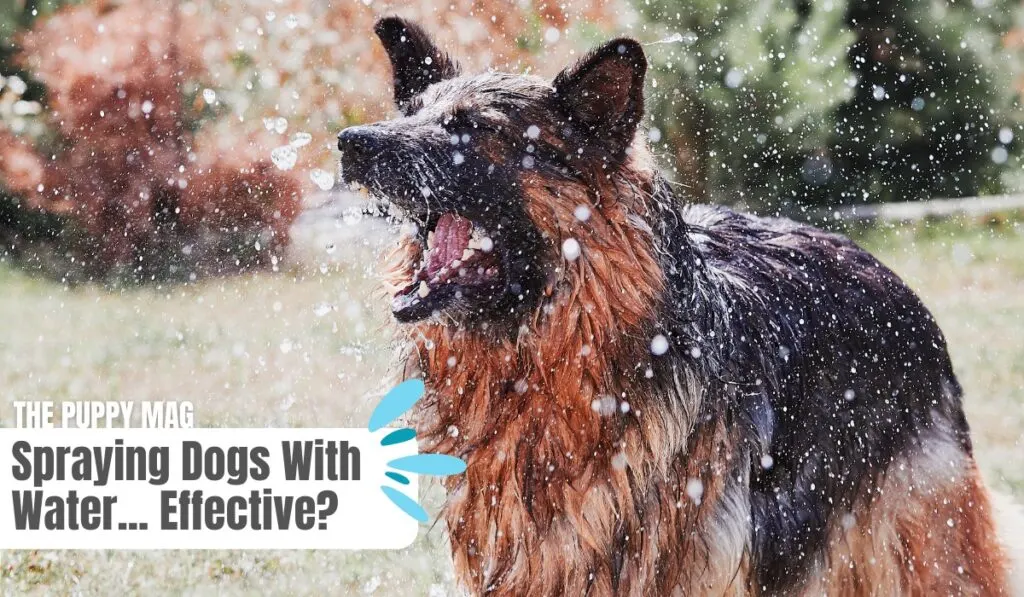As dog parents, we want our four-legged friends to exhibit good behavior, and we sometimes turn to various methods in an attempt to manage less desirable actions.
One such method often used is the spraying of dogs with water.
But is it truly effective? Let’s dive into this topic!

Spraying Dogs With Water
Spraying dogs with water as a means of discipline is a method where a person sprays a dog with a squirt bottle or a hose in response to bad behavior.
The concept behind this approach is to create a sudden and unexpected event that disrupts the dog’s undesirable action.
It’s a method that became popular in the ’80s and ’90s, viewed as harmless and an easy way to curb unwanted behavior.
However, recent insights reveal this method may not be as effective as once thought.
7 Reasons Why Spraying Dogs With Water Doesn’t Work
Contrary to previous beliefs, using a spray bottle is found to be largely ineffective for several reasons.
1. Negative Association with Spray Bottle:
Dogs often associate the spray bottle with punishment, leading to fear responses whenever it’s produced. Instead of learning to stop the bad behavior, they learn to fear the object.
2. Broken Trust with the Owner:
Spraying can lead to a breakdown in trust between the dog and the owner. Dogs might start regarding their owners with fear, associating the uncomfortable spray with their owner’s presence. This fear can extend to simple gestures like reaching out to touch them, leading to a negative impact on your relationship.
3. Affects Other Water-Related Activities:
If your dog starts to associate the spray bottle or water with punishment, they may begin to avoid other water-related activities. Bathing, grooming sessions, or fun swims might become a struggle.
4. Differing Attitude Towards Water:
Some dogs absolutely love water. In these cases, the water spray could actually become a positive reinforcement for the very behavior you are trying to curb.
5. Lack of Consistency:
Punishment for bad behavior needs to be consistent to be effective. If you’re not always there to spray your dog when it misbehaves, the method loses its impact, and the dog learns it can still get away with the behavior.
6. No Alternative Behavior is Taught:
Spraying a dog with water merely stops the behavior temporarily; it does not teach your dog the correct, alternative behavior.
7. Potential for Abuse:
When not used judiciously or appropriately, even a harmless water spray can turn abusive. It’s essential to remember that the goal is to help the dog understand right from wrong, not to instill fear or discomfort.
More Info: Animal Behavioral College
Better Ways To Discipline/Punish a Dog
Given the shortcomings of water spraying, other more positive and effective strategies can be adopted.
Positive Reinforcement:
One of the most recommended methods of training is positive reinforcement. This method encourages good behavior by rewarding it, often with treats, praise, or toys. The dog associates the behavior with a positive outcome, increasing the likelihood of them repeating it in the future.
Redirection:
If your dog is engaging in an unwanted behavior, try redirecting their attention to a more desirable action. For example, if they’re chewing on a shoe, swap it with their favorite toy.
Training Commands:
Teaching basic commands like ‘sit’, ‘stay’, ‘come’, ‘leave it’ can be incredibly useful in managing undesirable behavior.
Tips For Stopping Undesirable Behavior In Dogs
- Consistency is Key: Whether it’s in rewards or commands, consistency plays a crucial role in training your dog. Ensure everyone in the household is on the same page.
- Start Early: Training should start as early as possible to establish good behavior patterns from a young age.
- Patience and Understanding: Remember, dogs are not born understanding our rules. Be patient and compassionate in your approach.
- Consider Professional Help: If you’re struggling with your dog’s behavior, don’t hesitate to seek professional help. A certified dog trainer can provide valuable insights and methods tailored to your dog’s needs.
While spraying dogs with water might seem like an easy solution, it is often ineffective and can lead to unintended consequences.
The goal of discipline is not to induce fear, but to guide your furry friend towards better behavior.
Positive reinforcement, redirection, and patience will help in building a stronger, happier relationship with your dog.
Using Water Sprays as Part of Positive Reinforcement
Despite the drawbacks of using water spray as a form of punishment, some trainers have found ways to incorporate water sprays into positive reinforcement techniques.
For instance, if your dog enjoys water, you might use a spray bottle during playtime or during hot weather for a cool-down.
In these cases, the spray bottle isn’t used to discourage bad behavior, but instead as a reward or fun activity.
However, it’s crucial not to confuse the contexts. If you’re using water sprays both for fun and for punishment, this could confuse your dog and lead to ineffectiveness in both aspects.
Potential Fear of Water
One of the biggest potential risks of using water sprays as a disciplinary tool is instilling a fear of water in your dog.
This fear can extend beyond the spray bottle, potentially making baths, swimming, or even walks in the rain a stressful experience for your dog.
In severe cases, this could lead to a dog fearing to drink water from a bowl if it’s confused and associates it with the negative experience of being sprayed.
Final thoughts
Spraying dogs with water might seem like a simple solution to stop undesired behavior, but it’s far from being a reliable or kind method.
This approach can lead to negative associations, fear, confusion, and even potential health issues.
The keys to effective dog training are patience, understanding, and positive reinforcement.
By focusing on these principles, we can build a strong, trusting relationship with our furry friends while guiding them towards desirable behavior. After all, a happy dog makes for a happy home!
